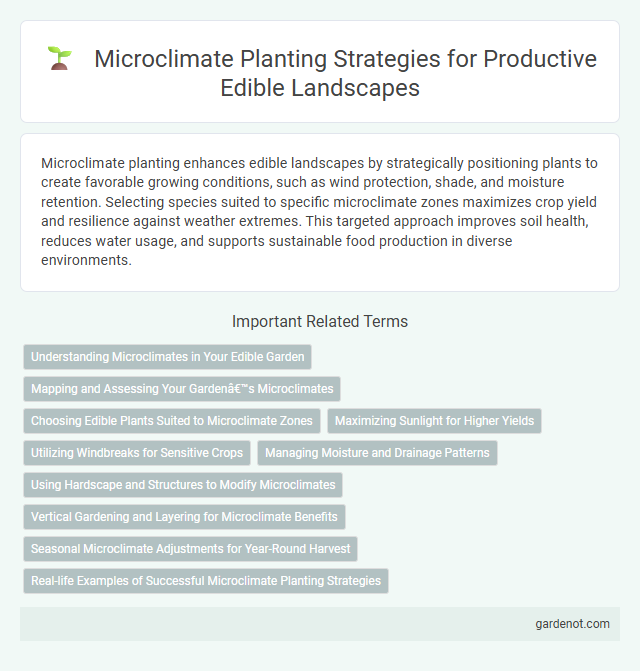Microclimate planting enhances edible landscapes by strategically positioning plants to create favorable growing conditions, such as wind protection, shade, and moisture retention. Selecting species suited to specific microclimate zones maximizes crop yield and resilience against weather extremes. This targeted approach improves soil health, reduces water usage, and supports sustainable food production in diverse environments.
Understanding Microclimates in Your Edible Garden
Understanding microclimates in your edible garden allows for strategic planting that maximizes growth and yield by considering factors such as sun exposure, wind patterns, and soil moisture levels. Identifying warmer or cooler zones within your garden helps select appropriate plant varieties that thrive under specific temperature ranges and humidity conditions. Effectively utilizing microclimate knowledge supports diverse crop cultivation, enhancing both productivity and garden resilience.
Mapping and Assessing Your Garden’s Microclimates
Mapping and assessing your garden's microclimates involves identifying variations in sunlight, temperature, humidity, and wind exposure across different areas. Use tools like thermometers, light meters, and soil probes to collect precise data for informed plant placement. Understanding these microclimates enables strategic microclimate planting, optimizing growth conditions for diverse edible plants and enhancing garden productivity.
Choosing Edible Plants Suited to Microclimate Zones
Selecting edible plants adapted to specific microclimate zones enhances growth and yield by leveraging localized temperature, sunlight, and moisture conditions. For warmer microclimates, heat-tolerant species like tomatoes, peppers, and sweet potatoes thrive, while cooler zones favor leafy greens, root vegetables, and brassicas. Understanding microclimate variables ensures optimal plant health, reduces water needs, and creates productive edible landscapes tailored to local environmental factors.
Maximizing Sunlight for Higher Yields
Microclimate planting strategically positions edible crops in areas with optimal sunlight exposure, enhancing photosynthesis and accelerating growth rates. Utilizing reflective surfaces and adjusting plant spacing increases light availability, directly boosting fruit and vegetable yields. Tailoring plant selection to specific sun patterns within the garden maximizes energy absorption and improves overall productivity.
Utilizing Windbreaks for Sensitive Crops
Windbreaks effectively modify microclimates by reducing wind speed, which protects sensitive crops from physical damage and water loss. Strategically planted rows of trees or shrubs create sheltered zones that maintain higher humidity and moderate temperature fluctuations. This controlled environment enhances crop resilience and promotes healthier growth in edible landscapes.
Managing Moisture and Drainage Patterns
Microclimate planting in edible landscapes involves strategically managing moisture and drainage patterns to create optimal growing conditions for plants. Incorporating swales, berms, and rain gardens helps redirect water flow, preventing erosion and waterlogging while promoting deep root hydration. Selecting plants with varying water needs based on microclimate zones enhances water efficiency and plant health across the landscape.
Using Hardscape and Structures to Modify Microclimates
Hardscape elements such as stone walls, patios, and pergolas play a crucial role in modifying microclimates within edible landscapes by absorbing heat during the day and releasing it at night, creating a warmer environment that extends the growing season. Structures like trellises and greenhouses shield plants from wind and frost, promoting healthier growth and higher yields. Strategic placement of these elements optimizes sunlight exposure and moisture retention, enhancing the overall productivity of the edible garden.
Vertical Gardening and Layering for Microclimate Benefits
Vertical gardening leverages walls and structures to create microclimates by providing shade, reducing wind exposure, and conserving moisture, which enhances plant growth in edible landscapes. Layering combines tall, mid, and ground-level plants to optimize sunlight distribution and soil humidity, fostering favorable conditions for diverse crops. These techniques improve yield and resilience by modifying temperature, airflow, and humidity within the garden environment.
Seasonal Microclimate Adjustments for Year-Round Harvest
Seasonal microclimate adjustments in edible landscapes optimize plant growth by leveraging natural variations in sunlight, wind, and temperature throughout the year. Utilizing windbreaks, thermal mass elements, and strategic plant placement creates favorable conditions that extend growing seasons and enhance yield. These techniques support year-round harvests by mitigating extreme weather impacts and promoting consistent microclimate stability.
Real-life Examples of Successful Microclimate Planting Strategies
Microclimate planting enhances edible landscapes by leveraging localized climate conditions to optimize crop growth and yield. For example, in San Francisco's foggy microclimates, gardeners successfully grow heat-loving fruits like figs and grapes by situating them near south-facing walls that retain warmth. Similarly, in the UK, orchardists use windbreaks and strategic tree placement to shelter tender fruit trees, creating microclimates that extend growing seasons and increase fruit production.
Microclimate planting Infographic

 gardenot.com
gardenot.com